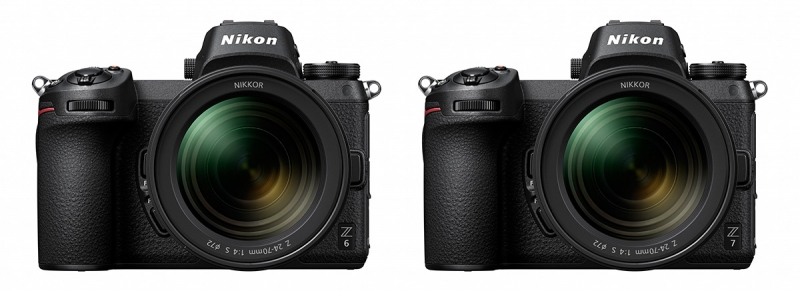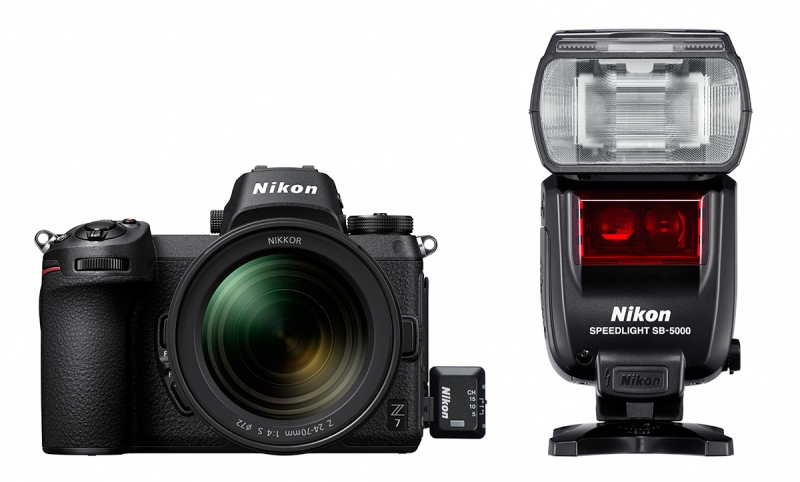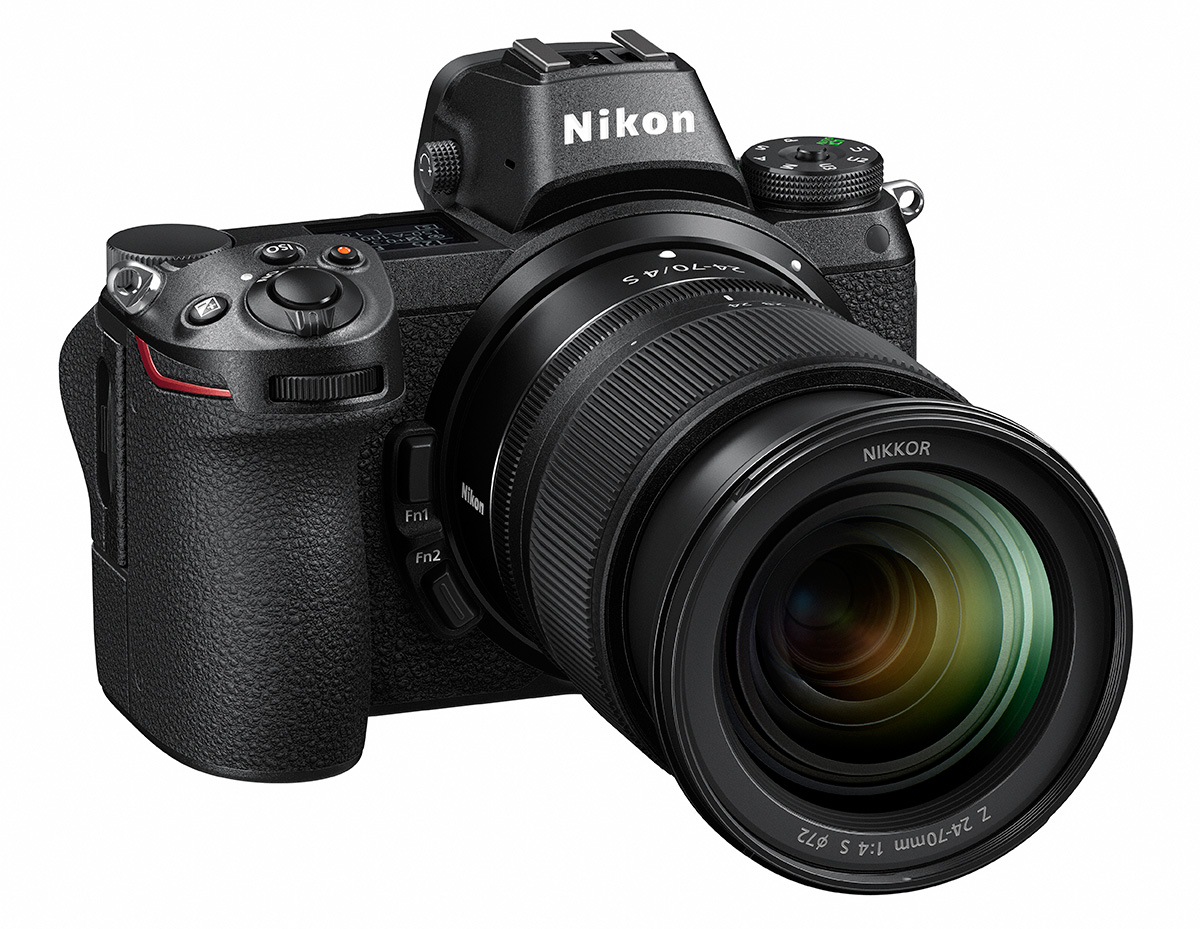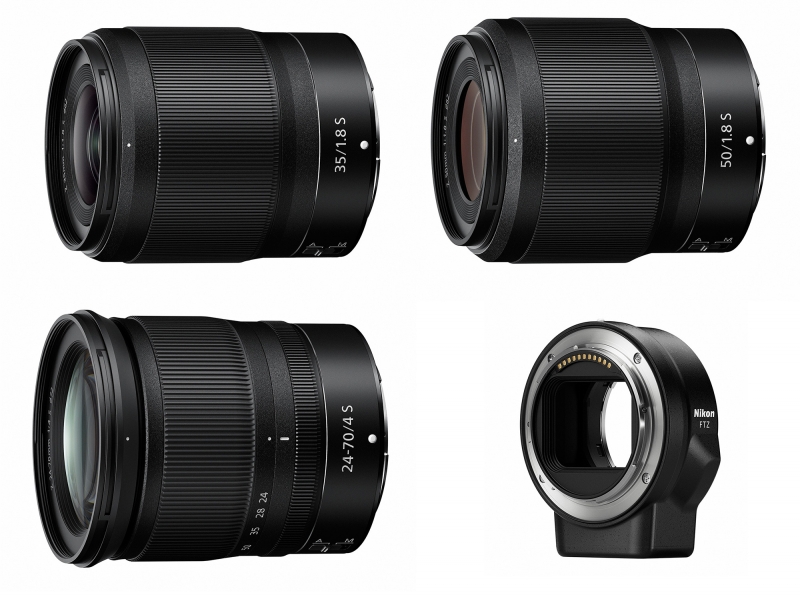Nikon announces new full-frame mirrorless cameras, new lens line
Nikon announces Z 6 and Z 7 full-frame mirrorless cameras and a new line of Nikkor lenses
8.23.2018
 Nikon has introduced two full-frame mirrorless cameras: the 24.5-megapixel Z 6, a body optimized for high speed and low light performance, and the high-resolution 45.7-megapixel Z 7. Both bodies are nearly identical in appearance, slightly smaller in width than a full-size speedlight is tall and only slightly taller than the same speedlight is wide. What's remarkable is how thin the body is except for the grip. The bodies are dominated on the front by the new 55mm diameter Z- bayonet lens mount and on the back by a 3.3-inch (diagonal) 2.1 million-dot touch-sensitive LCD monitor. Nikon says the Z 6 and Z 7 bodies have the same level of strength and durability, as well as dust- and drip- resistance, as the Nikon D850 but in a more compact body. The initial MSRP for the Z7 body is $3,339.95 ($3,999.95 for the Z 7 and Nikkor-Z 24-70mm f/4S kit), $1,995.95 for the Z 6 body, and $2,599.95 for the Z 6 / Nikkor-Z 24-70mm f/4 S lens kit.
Nikon has introduced two full-frame mirrorless cameras: the 24.5-megapixel Z 6, a body optimized for high speed and low light performance, and the high-resolution 45.7-megapixel Z 7. Both bodies are nearly identical in appearance, slightly smaller in width than a full-size speedlight is tall and only slightly taller than the same speedlight is wide. What's remarkable is how thin the body is except for the grip. The bodies are dominated on the front by the new 55mm diameter Z- bayonet lens mount and on the back by a 3.3-inch (diagonal) 2.1 million-dot touch-sensitive LCD monitor. Nikon says the Z 6 and Z 7 bodies have the same level of strength and durability, as well as dust- and drip- resistance, as the Nikon D850 but in a more compact body. The initial MSRP for the Z7 body is $3,339.95 ($3,999.95 for the Z 7 and Nikkor-Z 24-70mm f/4S kit), $1,995.95 for the Z 6 body, and $2,599.95 for the Z 6 / Nikkor-Z 24-70mm f/4 S lens kit.

SPECIFICATIONS
| Nikon Z 7 | Nikon Z 6 |
|---|---|---|
Effective resolution | 45.7 megapixels | 24.5 megapixels |
Sensor size and type | 35.9 x 23.9mm backside Illuminated CMOS | 35.9 x 23.9mm backside Illuminated CMOS |
Still image formats: | NEF (raw): 12 or 14 bit lossless compressed. TIFF: (RGB, 8 BPC) Baseline (1:4 compression), Normal (1:8 compression) Optimal quality compression is an option | Same as Z 7 |
Image size in FX (36x24mm) format (pixels) | Large: 8,256x5,504 Medium: 6,192 x 4,128 Small: 4,128 x 2,752 | Large : 6,048 x 4,024 Medium: 4,528 x 3,016 Small: 3,024 x 2,016 |
Image size in DX (24x16mm) format (pixels) | Large: 5,408 x 3,600 Medium: 4,048 x 2,696 Small: 2,704 x 1,800 | Large: 3,936 x 2,624 Medium: 2,944 x 1,968 Small: 1,968 x 1,312 |
Image size of still taken during 4K video filming | 3,840 x 2,160 | 3,840 x 2,160 |
Image size of still taken during other size video formats | 1,920 x 1,080 | 1,920 x 1,080 |
Other format ratios | 5:4, 1:1, 16:9 | Same as Z 7 |
Optical Low Pass Filter (OPLF | No | Yes |
Focal Plane phase detection autofocus pixels | Yes | Yes |
ISO Range | 64 to 25,600 | 100 to 51,200 |
Lo sensitivity setting | 32 | 50 |
Hi sensitivity settings | Up to 102,400 | Up to 204,800 |
Hybrid focal-plane phase detect and contrast-detect autofocus systems | Yes, with an algorithm based on information from the FX-format sensor which automatically switches between phase based and contrast detection AF system depending on image content and shooting mode | Yes, with an algorithm based on information from the FX-format sensor which automatically switches between phase based and contrast detection AF system depending on image content and shooting mode |
Autofocus points | 493 covering approximately 90% of the full frame area. | 273 covering approximately 90% of the full frame area. |
Electronic viewfinder (EVF) | 3,960K-dot (Quad VGA) OLED with 0.8x magnification and approx. 100% image area coverage, with Fluorine coat applied to viewfinder window to repel dirt. There is an option for the information menu to be displayed in the viewfinder so photographers can view and adjust different shooting settings. | Same as Z 7 |
Monitor | 3.2-inch approx. 2,100K-dot tilting TFT touch sensitive LCD with 170° viewing angle. Color balance and brightness controls. | Same as Z7 |
In-camera vibration reduction system (AKA IBIS) | The camera’s built-in vibration reduction (VR) system compensates for movement along 5 axes. Said to improve hand holdability up to 5 stops. This works with both Z-Nikkor and Nikkor F-mount lenses, but when using the FTZ adapter non-Z lenses are only stabilized in three axes. The in-camera VR can also work in conjunction with the image stabilization system in Nikkor VR equipped lenses. | The camera’s built-in vibration reduction (VR) system compensates for movement along 5 axes. Said to improve hand holdability up to 5 stops. This works with both Z-Nikkor and Nikkor F-mount lenses when using the FTZ adapter. The in-camera VR can also work in conjunction with the image stabilization system in Nikkor VR equipped lenses. |
Nikon EXPEED 6 Processing engine | Improvements claimed are a higher signal-to-noise ratio, increased perception of image sharpness | Nikon EXPEED 6 |
Picture Control | There is a new mid-range sharpening option with a 100 step adjustment range along with existing sharpening and clarity parameters and 20 Creative Picture Control options. A faster sensor assists with media flow buffering. | There is a new mid-range sharpening option with a 100 step adjustment range along with existing sharpening and clarity parameters and 20 Creative Picture Control options. A faster sensor assists with media flow buffering. |
Internal Media | Single XQD slot | Single XQD slot |
Internal Battery type | EN-EL15b but can be used with older EN-EL15 batteries (but capacity is reduced) | Same as Z 7 |
Shutter speed range | 30 seconds to 1/8,000 second in 1/3 or 1/2 stop increments, plus B and T modes | Same as Z 7 |
Flash sync speed | 1/200 second plus auto FP high-speed sync. | Same as Z 7 |
Release modes | Single, Continuous Low, Continuous Hi, High-speed Continuous extended, self-timer | Same as Z 7 |
Maximum Continuous Frame rate | Up to approximately 9 fps at full resolution FX format 12-bit RAW or 8-bit TIFF and JPEG formats | Up to 12 fps at full resolution FX format 12-bit RAW or 8-bit TIFF and JPEG formats |
VIDEO | Full pixel readout at 4K | Full pixel readout at 4K |
Formats | 4K UHD at 30p, Full-HD up to 120p, etc. Timecode support for syncing with other cameras and sound recording devices. | 4K UHD at 30p, Full-HD up to 120p, etc. Timecode support for syncing with other cameras and sound recording devices. |
Video profiles | The usual video profiles along with a special 10-bit N-Log profile can be used only with 10-bit HDMI output. The N-Log profile has a 12-stop “1,300%” dynamic range and greater color depth for better color grading during post-processing. | The usual video profiles along with a special 10-bit N-Log profile can be used only with 10-bit HDMI output. The N-Log profile has a 12-stop “1,300%” dynamic range and greater color depth for better color grading during post-processing. |
Focus peaking | Multiple settings for stills and video including a “peaking stack function” that facilitates confirmation of in-focus area when using the Focus Shift feature. | Multiple settings including a “peaking stack function” that facilitates confirmation of in-focus area when using the Focus Shift feature. |
Programable Intervalometer | Yes. Allows for creating 8K time-lapse sequences | Yes. |
Built-in Wi-Fi | Uses either Nikon’s SnapBridge app to connect to phones and tablets or for wireless transfer of images or video files to a computer | Uses either Nikon’s SnapBridge app to connect to phones and tablets or for wireless transfer of images or video files to a computer |
Multi-Power Battery / vertical grip | The MB-N10 is under development | The MB-N10 is under development |
Nikkor Z mount S-Line lenses and FTZ adapter
Both cameras are built around a new larger diameter lens mount Nikon calls the Z mount, which is 55mm in diameter. Interestingly, the wide fine-focus focusing ring on the Z lens will now be called a control ring and can be user programmed for purposes in addition to focusing.
The Z lenses will incorporate a new type of coating for internal lens surfaces to reduce chromatic aberration and internal flare. “An emphasis with these lenses is to make them as sharp wide open as traditional lenses are when stopped down two or three stops,” says Steve Heiner of Nikon. He also said that the new 50mm f/1.8 is designed to have zero optical aberrations when used wide open. All lenses will feature a nine-blade aperture for smooth transitions between in- and out-of-focus areas as well as a pleasingly soft renderings of areas that are out of focus.
The first three lenses announced are the Nikkor Z 24-70mm f/4 S that will also be available as the kit lens, the Nikkor Z 50mm f/1.8 S, and the Nikkor Z 35mm f/1.8 S.
The Z cameras are backward-compatible with Nikon F-mount lenses through use of the optional Mount Adapter FTZ. The Mount Adapter FTZ is a tube that makes up for the large difference in flange focal lengths between F-mount and Z-mount Nikon bodies. It has a fixed-position tripod mount. Nikon claims the FTZ has dust and drip resistance comparable to that of Nikkor F-mount lenses. There are more than 90 AF-S Nikkor lenses and more than 360 legacy Nikkor lenses.
I look forward to trying with the classic Nikkor 105mm f/2.5 AI-S with the new Z bodies and the FTZ adapter, especially with the camera’s internal VR. Note: There's no screw drive in the FTZ, so AF-D type Nikkors will be manual focus mode. All Nikkor F-mount lenses can make use of the camera’s internal VR cancellation capabilities but only in three axes, not five as with Nikkor Z lenses. If the Nikkor lens has internal VR it can work in conjunction with the camera’s internal VR. The Mount Adapter FTZ goes on sale Sept. 27 for $249.95. Through December, Nikon is offering a $100 discount when it's purchased with a Z 6 or Z 7 camera.
Nine more Z-mount lenses will be introduced in 2019 and 2020.
Special features of the Nikkor 24-70mm f/4 S:
- Minimum focus distance of 0.3 meters at all focal lengths
- Two ED (extra-low dispersion) elements, one of which is an aspheric shaped lens, and three other aspherical elements
- “Well-sealed” against dust and moisture
- Initial MSRP on September 27 launch: $999.95
Special features of the Nikkor 35mm f/1.8 S:
- Uses a multi-focusing system incorporating a pair of AF drive units for high-speed focusing with high accuracy while being quiet, fast, and accurate AF control
- “High image-forming performance at any focus distance”
- Two ED glass elements and three aspherically shaped elements
- Nano Crystal Coating on interior elements to reduce flare and ghosting
- Initial MSRP on Sept. 27 launch: $849.95
Special features of the Nikkor 50mm f/1.8 S:
- Auto focusing system is built around a powerful stepping motor (STM) enabling quiet and accurate AF control during both still and video shooting
- Two ED glass and two aspherical elements
- A high degree of suppression of axial chromatic aberration for superior resolution with faithful reproduction of the fine textures in subjects, even at f/1.8
- Introduction is scheduled for late October at an initial MSRP of $599.95
Future Z lenses
The fourth Z lens will be introduced in early 2019. It will be the Nikkor Z 58mm ƒ/0.95 S Noct. It will be the largest aperture Nikkor lens yet and is a manual focus lens. Price and introduction date have not been announced. It appears that it will be ideal for astrophotography, with the ability to render point light sources as true points of light.
After that 8 more lenses are in the 2019-2020 pipeline: a 20mm f/1.8, 85mm f/1.8, 24-70mm f/2.8, 70-200mm f/2.8, 14-30mm f/4, 50mm f/1.2, 24mm f/1.8, and 14-24mm f/2.8.
Finally, the Z system will be compatible with all the current Nikon Creative Lighting System compatible flashes.
Ellis Vener is a contributing editor to Professional Photographer.



